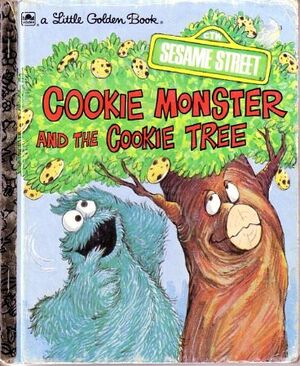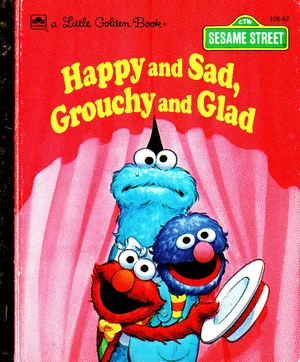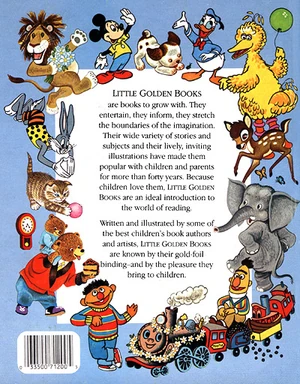





For a list of Little Golden Books, see the Little Golden Books category.
Western Publishing was a large publishing company based in Racine, Wisconsin, with editorial offices in both New York and Los Angeles. The company no longer exists. Mattel bought Western in 1982, then sold it off in 1984. Under new ownership, the company was renamed Golden Books Family Entertainment and focused on children's books. Random House acquired the book publishing property in 2001.[1]
Most people aren't familiar with the name Western Publishing, because it published under a number of different names. Western's publishing lines included Golden Books, Whitman Publishing, and Golden Guide. It also published comic books, as Dell Comics, Gold Key Comics and Whitman Comics, and produced a comprehensive line of Golden coloring books. In the early 1990s, Golden Books Family Entertainment also released a line of CDs and cassettes under the name Golden Music.
Western's most famous line, the Little Golden Books, began publishing in 1942. Many of the Sesame titles have been kept in print in various forms by Random House and Dalmatian Press.
Little Golden Books
In 1942, Western Publishing began its line of Little Golden Books, which is still running today under Random House. Little Golden Books are 24-page storybooks with large full-color illustrations on each page. The illustrations dominate each page, often including the book's text within the artwork. Their distinctive size (8" x 6½") and golden spine make Little Golden Books instantly recognizable.
The first set of 12 books, published in October 1942, included The Poky Little Puppy and The Little Red Hen. As of 2005, 15 million copies of The Poky Little Puppy have been sold.
Western began publishing Little Golden Books based on licensed characters in the late 40s with a line of Walt Disney books, including Dumbo, Uncle Remus and Peter and the Wolf in 1947, followed by Snow White, Bambi, Pinocchio and The Three Little Pigs in 1948. Warner Bros. joined the line in 1949 with Bugs Bunny and Bugs Bunny's Treasure Hunt, followed by Bugs Bunny's Birthday in 1950.
Sesame Street joined the line in the early 70s, beginning with The Together Book (1971), The Monster at the End of This Book (1971) and Bert's Hall of Great Inventions (1972). The Monster at the End of This Book was an instant bestseller -- in its first year of publication, the book sold two million copies. According to a 1973 Children's Television Workshop newsletter, "this figure, according to publishing sources, is an all-time one-year sales record for a single book."[2]
The Sesame Street line continued through the 1970s with Oscar's Book (1975), Big Bird's Red Book (1977), Cookie Monster and the Cookie Tree (1977), and Grover's Own Alphabet (1978). The four 1979 titles -- Ernie's Work of Art, The Four Seasons, The Many Faces of Ernie and The Amazing Mumford Forgets the Magic Words! -- are essentially comic books, with all of the text appearing in word balloons.
In his autobiography The Wisdom of Big Bird, Caroll Spinney recalled looking at a Little Golden Book: "Surrounding a list of other Little Golden Books titles was a border fashioned from a curving musical staff. Dancing along with the musical notes were Minnie and Mickey Mouse, Donald and Daisy Duck, Snow White and Dopey, Bugs Bunny and Yosemite Sam -- and Big Bird and Oscar. These were my characters, perfectly cartooned, dancing with my favorite cartoon characters from childhood... 'My God!' I said. 'I've gotten up there with Bugs Bunny and Mickey Mouse!'"[3]
Sesame Street Little Golden Books were published continuously through the 1980s and 1990s, with at least one new title (and often two or three) published almost every year. Titles included I Think That It Is Wonderful (1984), The Day Snuffy Had the Sniffles (1988), Big Bird Visits Navajo Country (1992), From Trash to Treasure (1993), and Another Monster at the End of This Book (a sequel to the 1971 book, featuring Grover and Elmo) (1996).
In the mid-90s, Little Golden Books published a small line of Muppet and Muppet Babies books, including Kermit, Save the Swamp! (1992), Fozzie's Funnies (1993), Baby Fozzie Visits the Doctor (1995), Muppet Treasure Island (1995), Miss Piggy, Queen of Hearts (1997), Ho-Ho-Ho, Baby Fozzie (1997), and Fozzie's Fabulous Easter Parade (1998). There were also two Big Bag books -- Chelli and the Great Sandbox Adventure (1996) and Chelli Tells the Truth (1997).
When the Tickle Me Elmo doll became the surprise hit of Christmas 1996, the Little Golden Books cashed in the following year with a batch of Elmo titles -- Tickle Me: My Name is Elmo, Elmo Loves You and The Bunny Hop -- as well as Big Bird's Ticklish Christmas. In another 1997 book, Golden Books combined two of their publishing powerhouses in The Poky Little Puppy Comes to Sesame Street.
The last Sesame Street Little Golden Books -- Big Bird's Baby Book, Elmo's New Puppy, Elmo's Tricky Tongue Twisters and First Steps -- were published in 1998.
Following the sale of the parent company's assets in 2001, Random House have continued to use the Little Golden Books brand as an imprint, with many of the Sesame Street titles remaining in print in various forms. Random House reprinted several titles under the "Jellybean Books" imprint in 1999, and Dalmatian Press has reprinted some as board books and paperbacks. One popular title, 1997's Elmo Loves You, was reprinted by Random House in 2000 as a Jellybean Book, and in 2002 as a board book, then by Dalmatian as a shaped board book in 2005 and a paperback in 2008.
In 2001, to celebrate the upcoming 60th anniversary of the first Little Golden Books, Random House began publishing a line of Little Golden Books Classics, beginning with reprints of six books. The Monster at the End of This Book was reissued as a Big Little Golden Book in 2004, and Another Monster at the End of This Book was added in 2009.
Whitman Tell-A-Tale Books
Another of Western's book lines was the Whitman Tell-A-Tale Books, which were published from 1945 to 1980. Tell-A-Tale Books were smaller than Little Golden Books (6¼" by 5½"), with thicker covers. The illustrations in these books were even more dominant -- the cover art extends all the way around to the back cover, and the art on the inside covers blends into the first and last pages. Tell-A-Tale Books were 28 pages long, slightly longer than Little Golden Books.
The first Sesame Street Tell-A-Tale Book, Sherlock Hemlock and the Great Twiddlebug Mystery, was published in 1972. It was written by Revena Dwight and illustrated by Roger Bradfield, the same team who had produced the first Sesame Little Golden Book, The Together Book. Sherlock Hemlock also starred in the next Tell-A-Tale Book, The Invention of Paper (1975), which was based on the recurring Sesame Street sketches with Ernie as a Caveman King.
The third Tell-A-Tale Book, How to Be a Grouch (1976), was Muppeteer Caroll Spinney's only children's book. The book offers a comprehensive look at Spinney's views on the character, including a page called "Learn To Be Miserable": "Getting new trash makes me happy, but I don't like being happy! Being happy makes me miserable, and I love being miserable! So that makes me happy -- which makes me miserable!"
Other Whitman Tell-A-Tale titles included The Count's Poem (1978), Ernie's Telephone Call (1978), Grover's Own Alphabet (1978), and The Up and Down Book (1979).
Golden Tell-A-Tale Books
In 1980, Western Publishing started another book line, Golden Tell-A-Tale Books, which would replace the Whitman books. That year, Monsters Come in Many Colors! was published in both the Whitman Tell-A-Tale and Golden Tell-A-Tale Book lines. Big Bird Follows the Signs was another 1980 Golden Tell-A-Tale title, followed by First Times and Sesame Street ABC in 1986.
First Little Golden Books
The Tell-A-Tale line made another transition starting in 1983, with the introduction of the First Little Golden Books. These books were slightly smaller than the Tell-A-Tale Books (6" by 5½"), and they were 24 pages long. They also had the Little Golden Books gold spine, which made the connection between the smaller and larger books more recognizable.
A few of the Tell-A-Tale Books were reprinted under the First Little Golden Books imprint, including The Count's Poem and First Times.
The Sesame First Little Golden Books also included I Can Dress Myself (1983), Count to Ten (1986), Big Bird's Busy Day (1987), Alice's First Words (1989), Shake a Leg! (1991), Grover's Mommy (1994), and Natasha's Daddy (1994).
The line also included one Muppet book, Sweet & Silly Muppet Poems (1992), and two Muppet Babies titles: Muppet Babies, Be Nice! (1993) and Let's Play Peek-A-Boo! (1996).
The last Sesame First Little Golden Book was Elmo Says... (1998).
Golden Book Video
A collection of videos known as Golden Book Video presented limited partial-animation adaptations of Golden Book titles. Illustrations from the books were displayed, accompanied by a full voice cast, and with stylized, limited animation effects. Quite a few Sesame Street books were adapted for these videos in 1985, released as Three Sesame Street Stories and Five Sesame Street Stories. Both videos were later combined into Eight Super Sesame Street Stories in 1990.
The videos were not officially Children's Television Workshop or The Jim Henson Company productions, but the companies were mentioned in the copyright notices. Emily Perl Kingsley was involved with the adaptation of the books. The only Muppet performers heard were Frank Oz, Caroll Spinney, Richard Hunt, and Fran Brill. Other main Muppet characters were usually characterized by the narrator describing their dialogue. The human cast members were renamed for the videos and voiced by one of the above performers (for example, Maria was renamed Dolores and voiced by Fran Brill). Occasionally, a somewhat minor Muppet character would be recast (for example, Slimey was voiced by a different actor and renamed "Squiggly," and Fran Brill voiced Rodeo Rosie). Unlike other Sesame videos or even book-and-audio sets, the usual Sesame Street background music cues by Joe Raposo were not used. Instead, stock tracks from the Associated Production Music library were utilized.
Other Western Publishing products
In 1981, Western released several Sesame Street activity sets featuring Put & Play reusable vinyl adhesive play pieces. These included books with a rear storage flap for pieces, laminated boards, bagged fold-out scenery boards, Put & Play Space Puppets with mix and match clothing, and the board games Put & Play Match A Color and Put & Play Match A Shape. The Put & Play product line also included Walt Disney and other favorite subjects.
In 1982, the company also released the You're A Grouch! card game.
In 1986, Western bought Penn Corporation.
References

- In Episode 1058 of Sesame Street, Big Bird uses some Little Golden Books as pretend school books in his imaginary school.
- Buffy shows Georgie a copy of the Golden Shape Book The Horse Book in Episode 1224 of Sesame Street.
- Elmo's copy of The 3 Little Pigs in Episode 4219 is listed as being from the "Little Golden Epics" series, and has a mock-gold binding.
External links
Sources
- ↑ "Golden Books sale cleared by bankruptcy court." Milwaukee Business Journal, August 16, 2001.
- ↑ Children's Television Workshop Newsletter. Number 27, February 1, 1973.
- ↑ The Wisdom of Big Bird, Caroll Spinney, Hyperion Books, 2003.